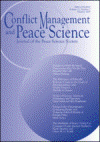Recent research identifies state capacity as a crucial determinant of civil peace. Scholars often interpret the association between wealth and peace as state capacity effects, but they have not clearly distinguished the impact of administrative reach and capacity for coercion from those effects that may capture good governance related to the provision of political goods and quality of institutions. We revisit the relationship between state capacity and civil peace by suggesting three different pathways through which the state avoids violent challenges to its authority: coercion, co-optation, and cooperation. We evaluate these three different notions of governing capacity both analytically and empirically, and we find that high levels of government spending on political goods and trustworthy institutions are more significant predictors of civil peace than are states’ coercive capacities. The results suggest that civil peace is co-produced by social and state forces, where quasi-voluntary cooperation from society increases state capacity for maintaining peace. This is good news for policies aimed at building state capacity, since there seems to be room for agency beyond simply waiting for societies to become wealthy.
Fjelde, Hanne & Indra de Soysa (2009) Coercion, Co-optation, or Cooperation? State Capacity and the Risk of Civil War, 1961–2004, Conflict Management and Peace Science 26 (1): 5–25.








